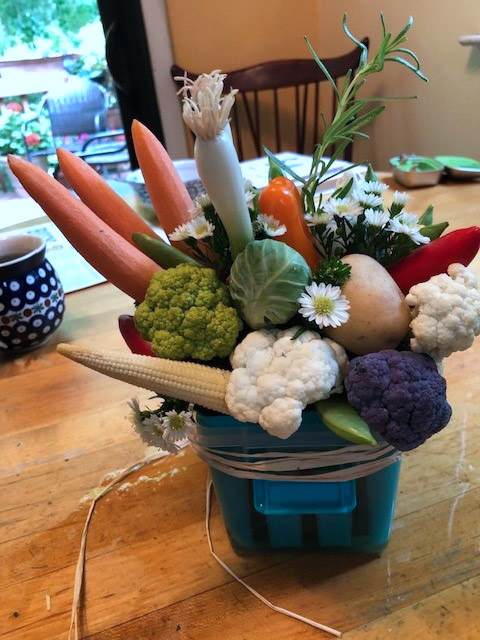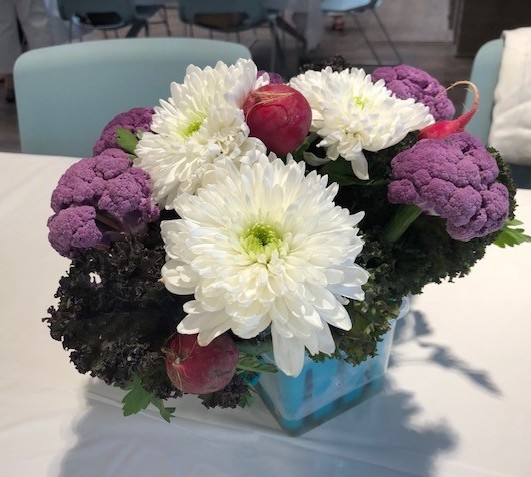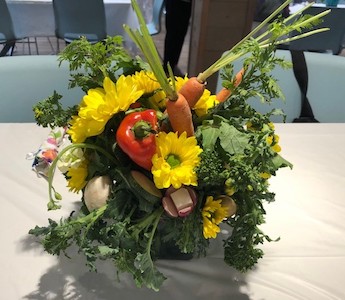Fruits and Vegetables in Floral Arrangements
By Elizabeth Cornell Fake, Fairfax Master Gardener
 If you think flowers are all you have in your garden to bring inside to make floral arrangements, think again! If you are growing fruits or vegetables and have beautiful specimens, bring them inside to add to the bouquet mix. End of season seed heads also add variety and texture to home-arranged floral designs. Don’t forget herbs to add scent and soft texture. You will be surprised to see what a nice arrangement they can be all together. Fruit and vegetable floral designs can be tricky to assemble and can be an architectural and mechanical challenge because of the weight and variety of the materials. Here are some guidelines to bring all of these diverse materials together for a satisfying blend.
If you think flowers are all you have in your garden to bring inside to make floral arrangements, think again! If you are growing fruits or vegetables and have beautiful specimens, bring them inside to add to the bouquet mix. End of season seed heads also add variety and texture to home-arranged floral designs. Don’t forget herbs to add scent and soft texture. You will be surprised to see what a nice arrangement they can be all together. Fruit and vegetable floral designs can be tricky to assemble and can be an architectural and mechanical challenge because of the weight and variety of the materials. Here are some guidelines to bring all of these diverse materials together for a satisfying blend.
Flowers
Do not forget the basic guidelines for gathering garden flowers to put into a floral design. Cut the blossoms mid-morning, clip the stems on an angle and put them in conditioned water to wait for arranging. If you are going to wait a day or so before using, refrigerate them. If you are going to use fruits and vegetables in your design, choose flowers that will be good filler flowers because the fruits and vegetables will become the focal points of the design.
Fruits and Vegetables
Select seasonal specimens from your fruit and vegetable gardens, looking for colors that will blend well with the flowers. Fruits that grow on vines like blueberries and grapes are an excellent choice as they add height and depth to a design. Smaller versions of citrus fruits such as kumquats, mandarin oranges, lemons and limes are more versatile than larger oranges and grapefruits and easier to secure to a design.

Fruits and vegetables in holiday arrangement
When selecting vegetables, remember a thick-skinned item will be sturdier in an arrangement than a thin-skinned cousin. But the possibilities are endless with cabbages, artichokes, asparagus, radishes, carrots, squash and Brussels sprouts. You can even use corn on the cob. Vegetables growing on vines such as gold and red cherry tomatoes, peas and beans also add variety to the mix. Don’t forget about kale and collards, which make great foliage at a fraction of the cost of traditional greenery. Whatever you select, retain the stem and if possible some of the branch of the fruit or vegetable when cutting. This will make it much easier to wire or tie into place. If you want to refrigerate the specimens before arranging, store them away from the flowers. Fruits and vegetables give off polyethylene gases that may cause the flowers to wilt.
Seed Heads
Seed heads have potential to bring a whimsical touch to any floral arrangement and blend well with fruits and vegetables. When the garden flowers have stopped blooming and have formed a seed pod, clip the branches holding the seed heads and bring them inside. Hang upside down to dry out for up to two weeks and keep in a dry place for future use. Rudbeckia, sunflowers, poppy pods, flax and scabiosa seed heads are some good choices.

Centerpiece arrangement
Herbs
Use herbs to augment traditional foliage in a fruit and vegetable design. Aim for three to four different types of traditional greenery plus some herbs. Look for hearty herbs that will hold up well without water. Good choices include chamomile, sage, rosemary, bee balm, dill and lavender.
Containers
Mixed bouquets need a sturdy container to provide a strong architecture for the design, more robust than a fragile glass vase or bowl. This is a good time to use a flat bottom wooden box, basket, metal vase or galvanized container. Keep in mind you want to create a casual theme to complement the diversity of the flowers, fruits, vegetables and other materials you have collected. Think about the proportion of the fruits and make sure you have a large enough container. Another possibility is to use a flat wreath form as the container centered around some floral foam blocks attached to the base. The wreath form gives a stable base for a taller arrangement.
Mechanics
Mechanics are the materials that hold the design together, and designers always try to make sure they can’t be seen. Floral foam is a standard material for most floral designs, although chicken wire and floral webbing are good alternative choices if you want an environmentally friendly alternative. You can find both at a hobby center or hardware store. With the addition of heavy fruits and vegetables to the arrangement, be sure to have some 22-gauge wire, 3mm jute twine and bamboo, metal or plastic picks to hold materials in place. Using wax floral tape or green tape wrapped around the mechanics will help camouflage the hardware.

Centerpiece arrangement
Assembly
The shelf life of a mixed arrangement can be as little as two or three days because the addition of fruits and vegetables will quickly accelerate the time for flowers to bloom fully. Plan carefully to make sure your arrangement will be at its peak when you want it to be. A good rule of thumb is to assemble on the day you want to use it. Begin with the heavier fruit and vegetable pieces, putting them into the center and bottom of the arrangement to keep it from falling over. If there are no stems, pierce the pieces with picks and push into place. If there are stems, tie or wire them into place. Continue with smaller vegetables or fruit, filler flowers, traditional greenery and if you want, add seed heads and herbs. Keep hydrated and out of the sun to ensure freshness and mist frequently. Enjoy your beautiful creation celebrating summer at its best.
References
• Fruit and Veggies Centerpieces, Have a Plant, Produce for Better Health Foundation
• How to Harvest Your Own Seed, Tips for Collecting Flower Seed, Nathalie Driver, Team
Flower Education
• How to : Using Fruits and Vegetables in Floral Arrangements, Dianna Miranda, The Dreamery Events,
August 1, 2018